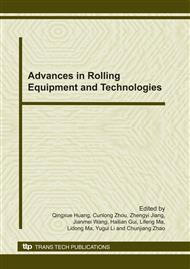p.210
p.216
p.223
p.230
p.238
p.243
p.248
p.254
p.260
Research on the Tendency of Inner Crack during 3-Roll Skew Rolling Process of Round Billets
Abstract:
Concerning the 3-roll skew rolling process of round billets, a 3-D thermo-mechanical coupled simulation is performed with the aid of commercial FE code MSC.SuperForm. The influence of the feed angle and inlet cone angle of the roll on the strain and damage filed are investigated. It is found that the distribution pattern of the equivalent plastic strain in the longitudinal section of the billet presents U-shape, and that the feed angle and inlet cone angle of the roll make difference in the gradient of deformation intensity in radial direction of round billet. The ring-shaped distribution of the damage field in transverse cross section of the billet indicates a high tendency for the ring-shaped inner crack to occur, instead of the center crack appearing in 2-roll skew rolling of round billet. The results show that the critical parameters to control the ring-shaped crack during the 3-roll skew rolling process are the feed angle and inlet surface cone angle of the roll. It should be avoided to use too large feed angles so as to reduce the tendency of annular inner crack in the actual rolling of high-alloy steels with poor hot workability.
Info:
Periodical:
Pages:
238-242
Citation:
Online since:
October 2010
Authors:
Price:
Сopyright:
© 2011 Trans Tech Publications Ltd. All Rights Reserved
Share:
Citation:


